2014 Peugeot 3008 Hybrid 4 spare wheel
[x] Cancel search: spare wheelPage 28 of 378

Hybrid system
26
The electronic power super visor - 4 automatically manages the operation of the two power units (Diesel and electric) to provide the lowest consumption. An inverter and a transformer are needed to manage the electric power. The inverter acts on the torque of the electric motor, by regulating the current coming from the high voltage battery pack. Its operating range is between 150 and 270 volts. The transformer converts the 200 V of the battery pack to 12 V, to power the vehicle's ancillary systems.
The alternator-starter motor - 5 assures the Stop & Star t function which allows the Diesel engine to be put into standby during stops (traffic lights, a stop, or in a traffic jam, for example) or during phases of running in all-electric mode. The stopping and restarting of the Diesel engine is done in a way that is instantaneous and transparent for the driver. It also provides additional charging of the batteries (4x4 mode for example or under-charged high voltage battery).
The electronic gearbox - 6 provides, in automatic mode, significant savings in fuel consumption compared to a conventional manual gearbox, thanks to its electronic control system. It also offers improved driving pleasure with the possibility at any time of choosing the gear changing mode: automatic or manual, using the paddles located behind the steering wheel.
Page 154 of 378
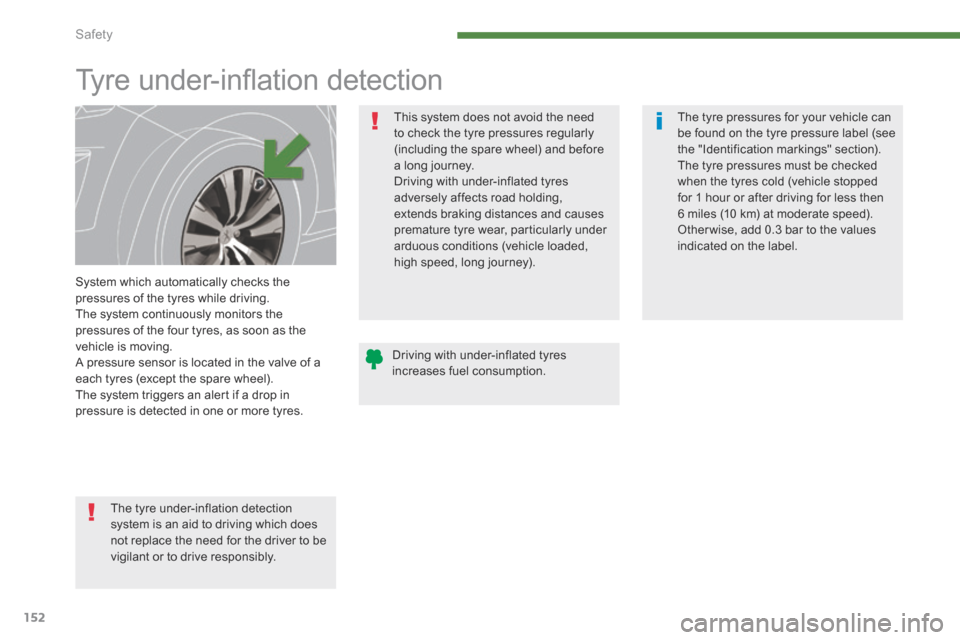
Safety
152
Tyre under-infl ation detection
System which automatically checks the pressures of the tyres while driving. The system continuously monitors the pressures of the four tyres, as soon as the vehicle is moving. A pressure sensor is located in the valve of a each tyres (except the spare wheel). The system triggers an alert if a drop in pressure is detected in one or more tyres.
The tyre under-inflation detection system is an aid to driving which does not replace the need for the driver to be vigilant or to drive responsibly.
This system does not avoid the need to check the tyre pressures regularly (including the spare wheel) and before a long journey. Driving with under-inflated tyres adversely affects road holding, extends braking distances and causes premature tyre wear, particularly under arduous conditions (vehicle loaded, high speed, long journey).
The tyre pressures for your vehicle can be found on the tyre pressure label (see the "Identification markings" section). The tyre pressures must be checked when the tyres cold (vehicle stopped for 1 hour or after driving for less then 6 miles (10 km) at moderate speed). Other wise, add 0.3 bar to the values indicated on the label.
Driving with under-inflated tyres increases fuel consumption.
Page 155 of 378
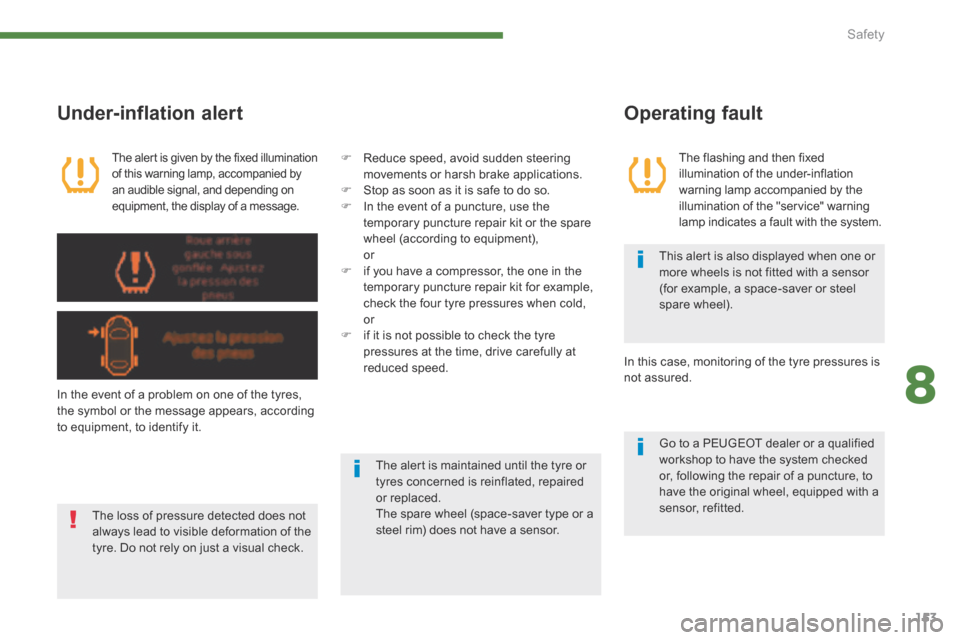
8
Safety153
Under-inflation alert
The alert is given by the fixed illumination of this warning lamp, accompanied by an audible signal, and depending on equipment, the display of a message.
In the event of a problem on one of the tyres, the symbol or the message appears, according to equipment, to identify it.
Reduce speed, avoid sudden steering movements or harsh brake applications. Stop as soon as it is safe to do so. In the event of a puncture, use the temporary puncture repair kit or the spare wheel (according to equipment), or if you have a compressor, the one in the temporary puncture repair kit for example, check the four tyre pressures when cold, or if it is not possible to check the tyre pressures at the time, drive carefully at reduced speed.
The loss of pressure detected does not always lead to visible deformation of the tyre. Do not rely on just a visual check.
The alert is maintained until the tyre or tyres concerned is reinflated, repaired or replaced. The spare wheel (space-saver type or a steel rim) does not have a sensor.
This alert is also displayed when one or more wheels is not fitted with a sensor (for example, a space-saver or steel spare wheel).
Operating fault
The flashing and then fixed illumination of the under-inflation warning lamp accompanied by the illumination of the "service" warning lamp indicates a fault with the system.
Go to a PEUGEOT dealer or a qualified workshop to have the system checked or, following the repair of a puncture, to have the original wheel, equipped with a sensor, refitted.
In this case, monitoring of the tyre pressures is not assured.
Page 205 of 378

11
Practical information203
The tools are stowed in the boot.
Access to the tools
Changing a wheel
Procedure for changing a faulty wheel for the spare wheel using the tools provided with the vehicle.
Before doing any work on your vehicle, switch off the ignition ( Ready lamp off) to avoid any risk of injury resulting from automatic operation of the engine.
When using lifting equipment (a jack for example), take care to use the jacking points provided, so as to avoid damaging the high voltage cables.
Tyre under-infl ation detection
The spare wheel (space-saver or steel rim) does not have a sensor. The punctured wheel must be repaired by a PEUGEOT dealer or a qualified workshop.
Page 208 of 378
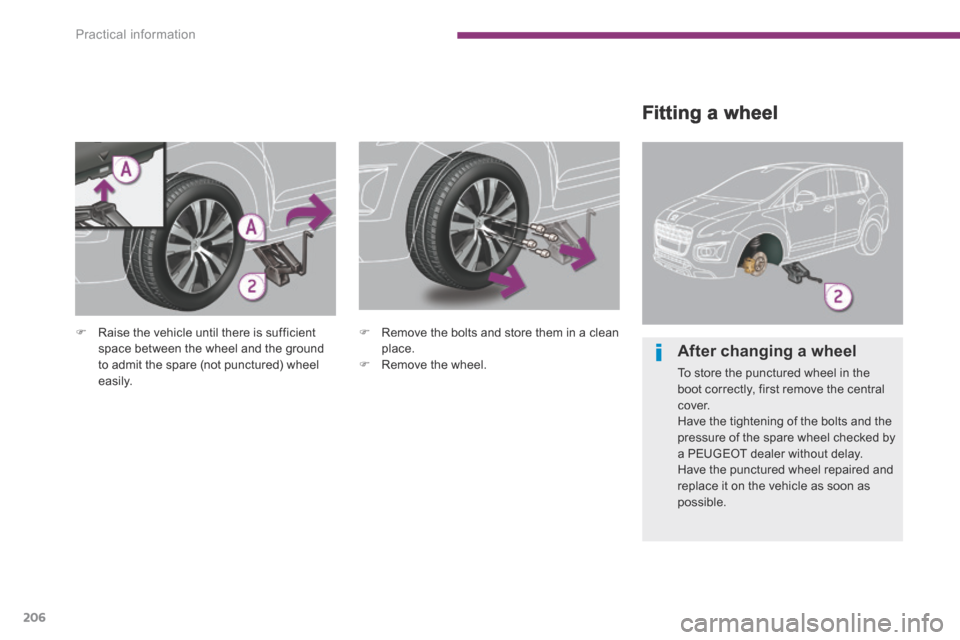
Practical information
206
Fitting a wheel
Raise the vehicle until there is sufficient space between the wheel and the ground to admit the spare (not punctured) wheel easily.
Remove the bolts and store them in a clean place. Remove the wheel. After changing a wheel
To store the punctured wheel in the boot correctly, first remove the central cover. Have the tightening of the bolts and the pressure of the spare wheel checked by a PEUGEOT dealer without delay. Have the punctured wheel repaired and replace it on the vehicle as soon as possible.
Page 210 of 378
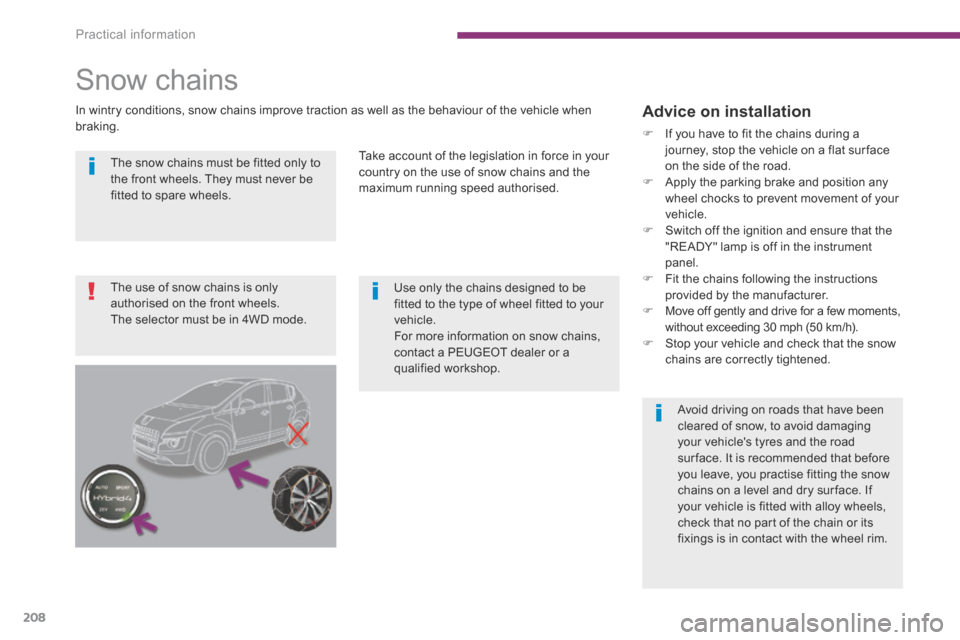
Practical information
208
The snow chains must be fitted only to the front wheels. They must never be fitted to spare wheels.
Use only the chains designed to be fitted to the type of wheel fitted to your vehicle. For more information on snow chains, contact a PEUGEOT dealer or a qualified workshop.
Avoid driving on roads that have been cleared of snow, to avoid damaging your vehicle's tyres and the road sur face. It is recommended that before you leave, you practise fitting the snow chains on a level and dry sur face. If your vehicle is fitted with alloy wheels, check that no part of the chain or its fixings is in contact with the wheel rim.
Snow chains
In wintry conditions, snow chains improve traction as well as the behaviour of the vehicle when braking.
Take account of the legislation in force in your country on the use of snow chains and the maximum running speed authorised.
Advice on installation
If you have to fit the chains during a journey, stop the vehicle on a flat sur face on the side of the road. Apply the parking brake and position any wheel chocks to prevent movement of your vehicle. Switch off the ignition and ensure that the "READY" lamp is off in the instrument panel. Fit the chains following the instructions provided by the manufacturer. Move off gently and drive for a few moments, without exceeding 30 mph (50 km/h). Stop your vehicle and check that the snow chains are correctly tightened.
The use of snow chains is only authorised on the front wheels. The selector must be in 4WD mode.
Page 241 of 378
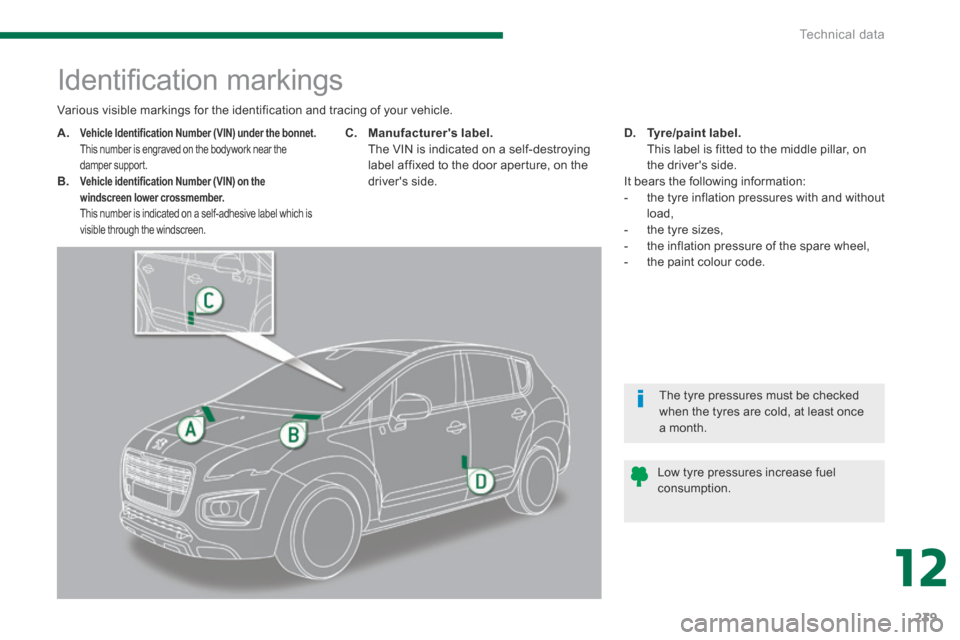
12
Technical data239
Identifi cation markings
A.Vehicle Identification Number (VIN) under the bonnet. This number is engraved on the bodywork near the damper support. B. Vehicle identification Number (VIN) on the windscreen lower crossmember. This number is indicated on a self-adhesive label which is visible through the windscreen.
C. Manufacturer's label. The VIN is indicated on a self-destroying label affixed to the door aperture, on the driver's side.
D. Tyre/paint label. This label is fitted to the middle pillar, on the driver's side. It bears the following information: - the tyre inflation pressures with and without load, - the tyre sizes, - the inflation pressure of the spare wheel, - the paint colour code.
Low tyre pressures increase fuel consumption.
Various visible markings for the identification and tracing of your vehicle.
The tyre pressures must be checked when the tyres are cold, at least once a month.
Page 368 of 378

Alphabetical index
366
Safety for children ..................137-150, 159, 161Screen, colour 16/9 .........................................68Screen, colour and mapping .......................................293, 332Screen menu map ........................278, 332, 356Screen, monochrome C .................65, 342, 356Screen, multifunction (with audio equipment) .....................65, 68, 70Screenwash fluid level ..........................118, 194Screenwash, front .........................................118Screen-wash reservoir .................................Screen-wash reservoir .................................Screen-wash reservoir19 4Seat adjustment ........................................80, 81Seat belts ...............................................157-159Seats, electric .................................................81Seats, rear .......................................................Seats, rear .......................................................Seats, rear85Serial number, vehicle ..................................239Service indicator .............................................Service indicator .............................................Service indicator61Service warning lamp .....................................55Servicing .........................................................40
S
T
POIs (updating) ....................................263, 300Port, USB .............125, 126, 272, 329, 350, 352Power ..............................................................Power ..............................................................Power32Priming the fuel system ................................19 0Protecting children .................137-150, 159, 161Puncture ........................................................197
Table of weights ............................................237Tables of engines .................................235, 236Tables of fuses ..............................................214
Radio .............................................267, 321, 347RCA sockets ........125, 126, 272, 329, 350, 352Reading lamps, rear ......................................Reading lamps, rear ......................................Reading lamps, rear121Ready ..............................................................28Ready lamp .....................................................28Rear foglamp.........................................212, 213Rear screen (demisting) ............................79, 88Recharging the battery .................................223Reduction of electrical load ..........................224Regeneration of the particle emissions filter .............................................................filter .............................................................filter195Reinitialising the electric windows ..................99Reinitialising the remote control .....................94Remote control ....................................90, 91, 95Removable screen (snow shield)..................232Removing a wheel ........................................205Removing the mat .........................................127Repair kit, puncture .......................................197Replacing bulbs ....................................20 9 -213Replacing fuses ....................................214 -2 20Replacing the air filter ...................................Replacing the air filter ...................................Replacing the air filter195Replacing the oil filter ...................................Replacing the oil filter ...................................Replacing the oil filter195Replacing the passenger compartment filter ......................................compartment filter ......................................compartment filter195
R
Replacing wiper blades.........................120, 226Reset history .............................................42, 72Resetting the service indicator .......................Resetting the service indicator .......................Resetting the service indicator62Resetting the trip recorder ..............................Resetting the trip recorder ..............................Resetting the trip recorder64Rev counter .....................................................Rev counter .....................................................Rev counter48Reversing camera .........................................185Reversing lamp .............................................212Risk areas (update) ..............................263, 300Roof bars .......................................................231Routine checks .....................................195, 19 6Running out of fuel (Diesel) ..........................19 0
Setting the clock .......................................67, 69Short-cut menus ...................................252, 294Sidelamps .............................108, 209, 210, 212Side repeater ................................................Side repeater ................................................Side repeater2 11SIM card ................................................125, 276Ski flap ..........................................................13 0Snow chains ..................................................208Spare wheel ..................................................203Speed limiter .................................................Speed limiter .................................................Speed limiter173Speedometer ............................................Speedometer ............................................Speedometer32, 48Spotlamps, side ............................................12 2Starting the engine .............................27, 28, 35Starting the vehicle .................................27, 292Steering mounted controls, audio ..................................................250, 345Stopping the vehicle ...............................28, 182Stop & Start .....................77, 189, 190, 192, 195Storage ..................................124, 126, 130, 132Storage box ...................................................125Storage wells ................................................132Sun visor ...............................................Sun visor ...............................................Sun visor125, 136Switching off the engine ...........................27, 28Synchronising the remote control ...........................................................94Synthesiser, voice .........................................306System, ASR .................................................15 6System, navigation...............................256, 295